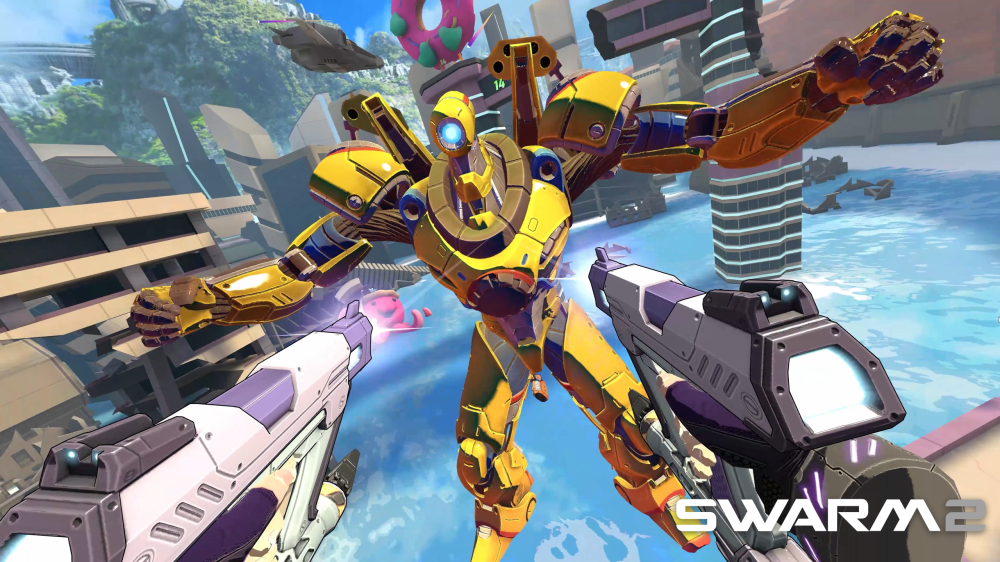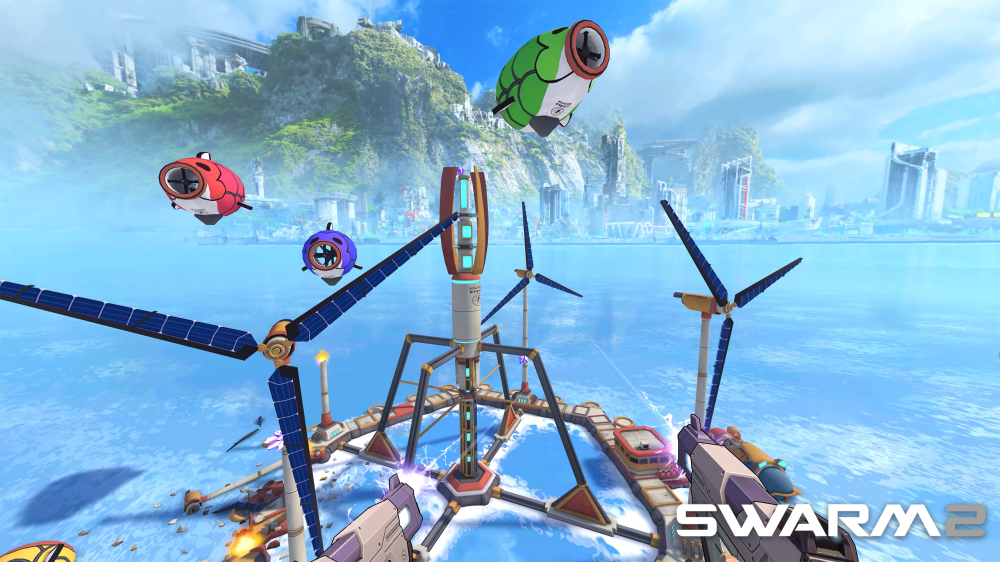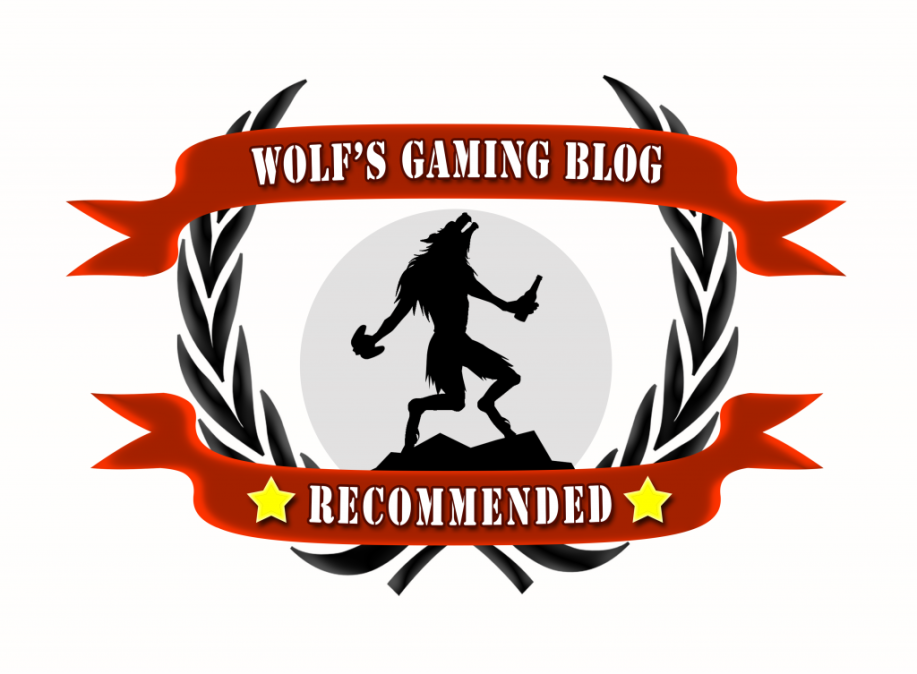VR can open the door to so many cool and interesting gaming experiences, and one of those was Swarm, an arena-based arcade shooter with an awesome way of getting around its environments. Swarm 2 seeks to build on that success by adding roguelike elements, a brave choice since that particular genre has arguably become over-saturated. So, is Swarm 2 a kickass sequel or does it need to do a few more runs to level up?
Here’s the awesome trick that makes Swarm 2 tick: you get to be Spider-Man, or at least as close as you’ll likely ever get. In each hand you have a gun that also fires out a grappling hook, letting you swing around the arenas like a chimpanzee on drugs. You’re always in movement for a couple of reasons: hitting the ground takes away health; you bounce off of objects you smack into; and finally, the numerous robotic drones, gunships and other metal bastards floating around are always shooting at you, so moving is the key to survival.
It’s very intuitive, at least to begin with. It doesn’t take long before you’re automatically glancing around to find the next enemy or solid object to latch onto, throwing out a hook and letting the momentum swing you up and into the air, that brief moment of hang-time acting as the perfect opportunity to get a bead on the enemy drones. There are some extra tricks to help you out too: a dash mapped to the left stick can be used to quickly regain momentum or completely shift direction, and by pulling on your ropes the lines can be tightened up, though the effect is far less than it was in the first game.
It’s when the action heats up that the whole thing becomes less intuitive, but that isn’t really the game’s fault – it’s mine. When things get crazy and my shields are low, my brain unhelpfully abandons all its knowledge about the basic laws of physics and panics, leading to moments where I get angry at not being able to reach the exact point I need. Thanks, brain, you are as helpful as always.
Available On: Quest 2, Quest 3, Quest Pro
Reviewed On: Quest 2
Developed by: Greensky Games
Published by: Greensky Games
Review code provided by the publisher.
What I can blame the game for is some of its busier environments. A couple of the arenas it drops you into are fairly crowded, so if you haven’t mastered the art of swinging gracefully through the sky then you’ll be less of a Tarzan and more of a George of the Jungle. Extra kudos to you if you got that reference. The point is, that the busier areas have a lot of stuff to smack yourself into, leading to a pinball effect as you bounce back and forth like an increasingly irate ball. Thankfully these moments aren’t too frequent and can be sorted out by taking a nice calm breath, channelling your inner Spider-Man and getting back into the groove.
And seriously, when you’re in the groove, Swarm 2 feels fucking amazing, with a massive skill ceiling for those willing to put in the work. Swinging around a pole and then catapulting yourself skywards is glorious, as is flying past a building, firing out a hook and swinging around the whole thing before flinging yourself back toward the enemy, guns blazing.
The guns! I haven’t even mentioned those yet. You had rapid-firing weapons attached to both of your hands and each arena is filled with drones, ranging from small blighters to big bastards that launch rockets. Your singular goal is to shoot them all out of the sky to open a portal to the next arena. It’s that simple, yet executing that plan is challenging because you’ll have to juggle swinging around while pinpointing foes and raining down hellfire. While Swarm 2 can be played sitting down, I think it goes without saying that this is a game best experienced standing, preferably with room enough for you to spin around in circles without fear of getting tangled up or smacking something with a hand. Being able to do that makes the gameplay far more satisfying because you spin 180 degrees mid-swing to shoot backwards or maybe even drop to a knee so you can perforate a large drone as you Tarzan underneath it.

There are special weapons to grab mid-mission too, providing a little extra spiciness. Homing missiles, miniguns and more will pop up from time to time, though they have limited ammunition, unlike your default pistols.
Throughout the campaign three boss battles will also pop up to put your swinging skills to the test. I just read that sentence back – it sounds pretty dirty, but I’m sticking with it. The first boss makes a hell of an impression, a massive robot that looms over the arena. Don’t worry though, because he’s covered in convenient weak spots which when shattered leaves the robot vulnerable to damage. It’s a lot of fun to tackle this fight, and there’s a great sense of scale as you whip through the air, evading barrages of missiles and swinging back around for another drive-by shooting. However, the other two bosses are just the same thing again: big giant enemies with weak points that you swing around in circles.
All this swinging about feels like it should deliver a straight shot of motion sickness right into your stomach, and yet Swarm 2 somehow avoids that. While I do have a decent pair of VR legs beneath me, I still typically get a little woozy on the fast games with lots of motion, but Swarm 2 never bothered me. Credit must be given to the performance, too, because the game stayed super-smooth during my time with it on a Quest 2 headset. In a game like this, even a little bit of stutter would have made me vomit up my dinner, so I’m grateful that it was as consistent as my hatred of mornings.
But what’s new!?
So far, if you’ve played the original Swarm everything I’ve said is going to sound rather familiar. The core gameplay is almost identical to what it was before, minus a few small tweaks here and there. That begs the simple question: what’s new?
Well, when in doubt throw in a roguelike. The main mode is no longer an infinite loop, rather it throws you into a series of 18 levels, with each sixth level being one of the boss battles we discussed. Between stages, you’re given the chance to pick from one of three perks that’ll boost your abilities. That might be special corrosive damage, a chance to ignore hits or something else that will aid in your battles.

Whenever you end a run, usually due to being shot or blown into itty bitty pieces, you’ll level up which will in turn unlock new perks that have a chance of appearing between levels, as well as new weapon drops that might spawn in a level.
Finally, there are special shards you’ll pick up in levels that act like a currency which you can spend to increase shield capacity and health, or even to unlock special powers such as slow motion.
Obviously, the goal is to hurl yourself into run after run, each failed attempt delivering resources that can be poured into giving you a slightly better chance on the next try. The game’s high skill ceiling means that the more talented players out there will be able to reach the final boss far easier, and likely post some damn good scores on the leaderboard, but thanks to the gradual flow of improvements everyone will be able to get to the final battle provided they are willing to keep going.
But the question is whether the desire to keep going will be there. Roguelikes can be tricky to get right because their nature means players have to replay a lot of the same content over and over. The best of them use this idea to their advantage, such as Hades or the more recent Have a Nice Death, but Swarm 2 struggles to keep each run feeling fun and fresh. There’s a solid selection of environments to do battle in, but there isn’t a lot of enemy variety, nor is there really any storyline to speak of. While it is satisfying to pick perks that complement each other, none change the gameplay. So after a few hours with the game, I found myself struggling to keep pushing for another run at the last boss or another personal best score.
I think whether you’re going to like Swarm 2 will come down to how you feel about roguelikes and their current prevalence in gaming. For me, I like the idea of building a roguelike into Swarm’s already excellent gameplay, but a lot more could have been done with the idea to help keep it engaging. Still, even though I think the roguelike additions are fairly basic, it’s an improvement over the first game which was simply a neverending loop of levels. Swarm 2 has more focus and can be ‘beaten’.
A couple of major updates are planned for the rest of the year, kicking off with basic quality-of-life changes and graphical improvements for Quest 3 players. The bigger stuff will start coming in July when 10 new arcade arenas. A further update later will add melee weapons into the mix, which could prove very interesting.
Taken on its own merits, Swarm 2 is heaps of fun and an incredibly cool virtual reality experience. Swinging around like a gun-toting Spider-Man is immensely satisfying. As a sequel, I think it’s a little bit disappointing because the roguelike elements don’t add much, at least for myself. Others may find the emphasis on gradually building up power more enjoyable than I did.
This means when it comes to recommendations, I can easily say that anyone who didn’t play the first game should jump straight into Swarm 2. It’s a fantastic game for the Quest with some of the best movement around. If you did play the first game though, give some careful thought to how you feel about roguelikes, because if you aren’t a huge fan then Swarm 2 probably isn’t going to do it for you, unless you just want more of the core gameplay in some different settings.

